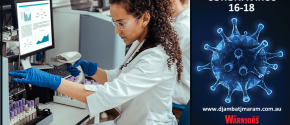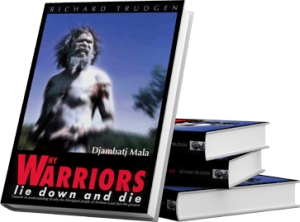During our latest community education, we were trying to find out where Yolngu people were at, we asked: “What picture do you get when you hear doctors or nurses talking about bacteria or germs?” Almost all Yolngu participants replied, “Yan dhäruk” – just a word. They did not see little living things, so they could not relate to what the Covid-19 virus was. Existing as ‘just words’, the virus is out there somewhere in the mythical realm, where people felt they have no control over it.
The only information stored in their memory around these words is the shape of the letters or the sound of the words themselves. They do not see bacteria or germs as tiny little “living things” that can multiply in their bodies and transmit from one person to another through their saliva or mucus droplets.
This is why so many Aboriginal people become vulnerable to conspiracy theories and anti-vax propaganda. It is also the reason why Rheumatic Heart Disease (RHD) is out of control in their communities, and the health gap between Aboriginal Australians and mainstream Australia never closes!
English terms around Covid-19 virus and RHD also confused them. Yolngu asked what the word Covid-19 means?, or what “corona” and “second wave” and other English words meant? All of these terms just added to the confusion, and some conspiracy stories played on this. So early in the pandemic, we produced programs and videos around these difficult English phrases. “Rheumatic” and “heart” also cause issues and many traditional Aboriginal people are not sure of the role of the heart in the body. For many, it is not even connected to the puls points that they can identify all over their bodies. Please see the video on Heart Attack to get a clear understanding of this
When we reveal the true meaning of these words, many Yolngu adults also ask, “so what does infection mean?”
Through previous analysis, we knew the knowledge gaps and contradictions that many Yolngu people in Galiwin’ku would have in relation to disease and sickness:
- Many Yolngu believe that sickness is caused by magic/ sorcery, some form of spiritual intervention, sickness country, or poisoning.
- Many Yolngu have no clear understanding of the cause and effect of disease and sickness.
- Many Yolngu feel a disconnect between themselves and the medical interventions needed to treat their conditions. Medicines and even operations are being seen as ‘magical’ in some way.
If Yolngu think about viruses, germs and bacteria differently from other living creatures, confusion sets in, and conspiracy theories can take hold because viruses are disconnected from their real world. They see somebody else as spreading or causing it, whatever it is? If bacteria, germs and viruses are inanimate, they can’t reproduce in our bodies or be transmitted from one person to another. This makes it someone else’s problem, and the people have no role to play in it.
Conspiracy theories are rife in remote communities around the idea that “the government or some group of people have produced the virus;
“to limit the population of the world”.
“get people to take the vaccine, with a chip in it, so the government can take control of them”.
“so you’ll turn into a zombie after a week or two.
“when the code in the vaccine gets to 666 you will die”.
“has Satan in it, so he’ll live inside you”.
Inanimate thinking destroys the cause-and-effect relationship of any basic, true dhuḏi-dhäwu, evidential information.
Yolngu people understand how the animals around them breed and can be helpful or harmful to human life. They also need this same information on bacteria and viruses.
Over the last two months, we have worked through bacteria, germs, and viruses as animate “living” creatures during many face-to-face education sessions. We even work on how viruses are very different to bacteria. Yolngu are very interested in all this information because it is the sort of information they expect to know about other living things in their home environment.
This has massive implications on the Covid-19 pandemic and other health programs because, without this foundational knowledge, none of the strategies of social distancing, vaccines, wearing masks, or washing hands make any sense.
At the beginning of the pandemic, when the government told people to wash their hands, many Yolngu washed their hands at least once a day as they saw this as some form of prayer. There was no clear cause-and-effect relationship to the information.
Many mainstream people claim that “Yolngu are wearing masks when we tell them to put them on”, and yes, they will comply with instructions and wear them for a while. But inanimate thinking leads to viruses being mystical. So most believe that washing hands is a form of religious activity and that masks are some form of a religious relic that can stop the effects of magic or spiritual activities. However, the prayer or the wearing of religious relics only needs to be done once or twice to provide protection.
This is the same thinking Europeans had during the black plagues of Europe.
The black plagues of Europe are common knowledge for most Europeans but not for many Yolngu and most other Aboriginal people. In fact, one of the questions we received from Yolngu was, “Why are Balanda so frightened of Covid-19”? So we produced a program on the plagues of Europe.
The people want to know the truth and have a right to know the truth. Without it, informed consent will remain a distant reality that will never be achieved.
For over 30 years, I have been advocating for health literacy programs in remote First Nations communities to teach people about germ theory in a culturally appropriate way. Unfortunately, this has not yet been achieved, mainly because most mainstream, English-first-language people consider everyone else in Australia to have the same worldview or knowledge they have.
Microscope literacy or germ theory
The following is a deeper discussion about the education with a microscope process.
During education sessions, we conduct “microscope literacy” sessions by projecting microscope images up on a projector screen[1]. This must be done in a culturally appropriate way, working from where people are at, and taking into consideration that most Yolngu people in remote communities have little or no understanding of how a microscope works. (We will be happy to teach people this process)
First, we demystify the microscope, showing them how it works. Then we place our saliva on a slide and show them the bacteria and germs that exist in it.
When people see live living little creatures in the saliva, they are blown away. We then explain that our bodies, our white blood cells (immune system), are used to all these bacteria, so they won’t make us sick. But if we were to put our saliva in their mouths, they would get sick from something. That is because their immune system is not used to these strange new bacteria.
Immediately people start talking about how they are making each other sick by sharing food, cups, and other things without them being washed. The cause and effect of disease and sickness become clearer because germs are no longer seen as inanimate. They are now seen just like the animals in the bush or the fish in the sea. They are living and thus capable of being helpful or harmful. People also see that they have a role to play in managing or controlling them.
Yolngu have a strong connection and understanding of nature, particularly the animal world, knowing there are harmful and non-harmful animals in their living environment. They have less trouble dealing with this reality than most mainstream people do. In fact, this knowledge is so fundamental to them, allowing them to contextualise the conversation in real-life terms, leading to many other questions.
Many Yolngu ask, “Have they got names”? They want to know about them and learn about them, just like the other living animals around them. So we talk about some of the diseases they know about, like TB, melioidosis or rheumatic heart disease. They did not know these diseases were caused by little living creatures.
We go on to explain how germs reproduce and if we are lucky, we might even see one of them reproducing on the image being projected on the screen as we worked through the live microscope lesson.
Then we explain that most of those bacteria are bodinynha (peaceful, calm) and helpful to us. Only a few will be madakarritj (angry, cranky, aggressive) and can harm us, making us sick, like some poisonous creatures.
We explain how viruses are much smaller than bacteria and can multiply many times faster in our bodies. Where germs and bacteria eat food and multiply by mitosis, doubling their number about every ½ an hour, viruses do not eat food. However, they can inject their reproduction code inside our body cells and reproduce thousands of offspring, destroying our body cells as they do it.
This conversation brings people back to a clear cause-and-effect relationship and dispels the idea of a mystic spiritual reason out there and that Covid-19 or RHD is someone else’s responsibility. This education method places the control back in the hands of the people.
Finally
Yolngu deeply value their kinship system and family groups. As they became aware of how Covid-19 could be transmitted through their closest kin, many asked, “Is there any way to stop Covid 19 from getting into our family group”? We explain that the only way at the moment is to get vaccinated. This will limit the reproduction rate of the virus and, therefore, the spread of the virus. Most doctors are also saying that it will also help stop you from getting critically ill from it.
Richard Trudgen
Community Educator Dec 2021



